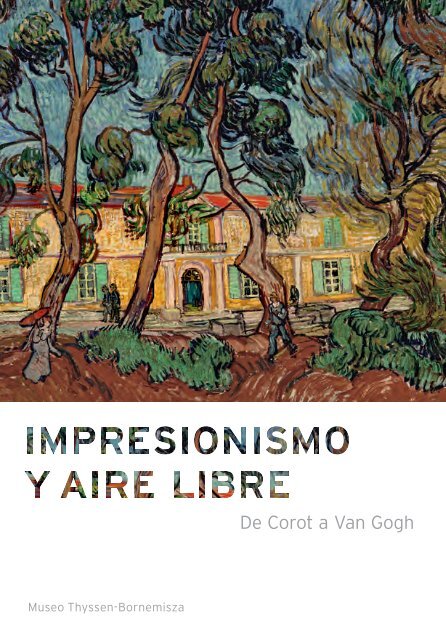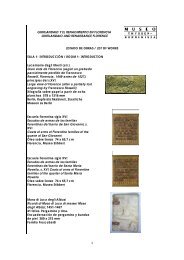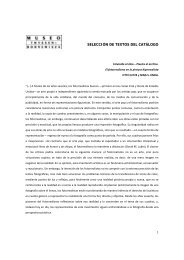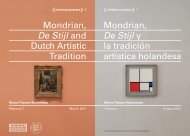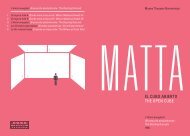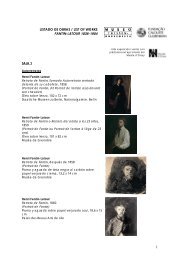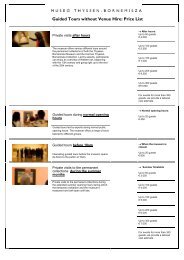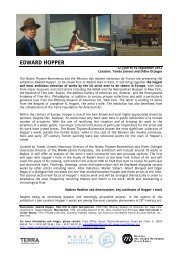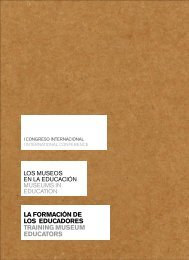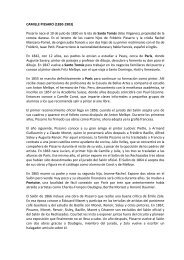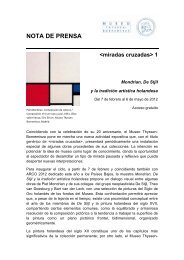folleto - Museo Thyssen-Bornemisza
folleto - Museo Thyssen-Bornemisza
folleto - Museo Thyssen-Bornemisza
You also want an ePaper? Increase the reach of your titles
YUMPU automatically turns print PDFs into web optimized ePapers that Google loves.
<strong>Museo</strong> <strong>Thyssen</strong>-<strong>Bornemisza</strong>
Jules Coignet<br />
Pintores al aire libre en el bosque de Fontainebleau (detalle), 1825<br />
Painters in the Forest of Fontainebleau (detail)<br />
Barbizon, Commune de Barbizon, colección del Musée<br />
Départemental de l’École de Barbizon
IMPRESIONISMO Y AIRE LIBRE<br />
La presente exposición se propone introducir al espectador en la problemática<br />
de la pintura al óleo al aire libre, práctica artística que alcanzó su<br />
máxima expresión con el impresionismo, pero cuyos orígenes se remontan<br />
casi un siglo atrás.<br />
Desde finales del siglo XVIII, fue frecuente que los jóvenes paisajistas<br />
que se formaban en Italia se ejercitasen con pequeños estudios al óleo pintados<br />
del natural. Considerados por Pierre-Henri de Valenciennes (1750-1819),<br />
paisajista neoclásico y padre de la pintura al aire libre, como obras menores<br />
respecto a las composiciones finales ejecutadas en el taller pero esenciales<br />
en el aprendizaje del artista, su función principal era la de servir de ejercicios<br />
de destreza tanto para el ojo como para la mano. Indirectamente, se<br />
IMPRESSIONISM AND OPEN-AIR PAINTING<br />
The aim of this exhibition is to illustrate the development of oil painting in<br />
the open air, a technique which reached its height with Impressionism, yet<br />
originated almost a century before.<br />
From the late 18th century, young landscape artists often practised<br />
during their period of training in Italy by painting small oil studies outdoors.<br />
Regarded by Pierre-Henri de Valenciennes (1750-1819) — a Neo-classical landscape<br />
artist and the father of plein air painting — as minor works when compared<br />
with compositions completed in the studio, yet essential to the learning<br />
process, these studies served as exercises for developing the expertise of<br />
both hand and eye. Indirectly, the intention was that they would provide the<br />
landscape artist with a repertoire of motifs for future use in compositions
pretendía que a través de ellas el paisajista adquiriese un repertorio de posible<br />
uso en el futuro, en sus composiciones acabadas, y que recurriese a su<br />
memoria visual más que a su imaginación. En cualquier caso, los estudios al<br />
aire libre quedaban restringidos al ámbito privado del artista.<br />
Durante la primera mitad del siglo XIX, la neta distinción entre paisajes<br />
del natural y composiciones de estudio se fue desdibujando. Desde la década<br />
de 1820, se produjeron trasvases entre ambos formatos que implicaron un<br />
acabado más cuidado de los óleos pintados al aire libre y la utilización de<br />
motivos tomados del natural en las composiciones ejecutadas en el estudio.<br />
Artistas como Corot y Constable extendieron la práctica de la pintura del<br />
natural al conjunto de su producción, y pronto la moda de los estudios al<br />
óleo del natural se extendió a gran parte de Europa y de los Estados Unidos.<br />
De manera paralela, los estudios al óleo pintados al aire libre ganaron reconocimiento<br />
e independencia, sobre todo entre los artistas pertenecientes a<br />
la Escuela de Barbizon (Rousseau, Diaz de la Peña, Dupré, Daubigny, etc.),<br />
quienes frecuentaron el bosque de Fontainebleau, a unos 60 kilómetros al<br />
sur de París. Algunos de ellos optaron por presentar sus estudios del natural<br />
en los certámenes oficiales, junto a sus obras más acabadas.<br />
Monet, Sisley, Renoir, Bazille y Cézanne frecuentaron el bosque de Fontainebleau<br />
en la década de 1860, donde tomaron el relevo de la Escuela de<br />
Barbizon. Con ellos, el trabajo en el taller pasó a segundo plano, y la espontaneidad<br />
y la rapidez de ejecución que habían sido consustanciales de los<br />
estudios al aire libre se convirtieron en uno de los fundamentos de su pintura.<br />
De este modo, los estudios al aire libre —en su función tradicional de apoyo a<br />
la creación artística—, dejaron de tener sentido, pues ellos mismos pasaron a<br />
convertirse en el centro de la práctica artística. Pero la aparente libertad del<br />
trabajo del natural no tardó en convertirse en una traba a la creación plástica.<br />
Monet, quien en 1880 aseguraba no poseer otro estudio que la naturaleza,<br />
empezó por las mismas fechas a concluir sus obras en el taller.
for which he would be able to draw on visual memory rather than imagination.<br />
Whatever the case, open-air studies ultimately became restricted to<br />
the artist’s private working practice.<br />
During the first half of the 19th century, the clear-cut distinction between<br />
landscapes painted out-of-doors and those executed in the studio<br />
began to break down. From the 1820s there was a greater degree of crossover<br />
between the two methods with a more careful finish evident in open-air<br />
oils and the use of motifs taken from nature in studio compositions. Artists<br />
such as Corot and Constable extended the practice of painting directly from<br />
nature to their work as a whole and the fashion for oil studies of this kind soon<br />
swept across most of Europe and the United States. At the same time, such<br />
studies gained increasing recognition and independence, particularly among<br />
the Barbizon School artists (Rousseau, Diaz de la Peña, Dupré and Daubigny<br />
among others), who frequented the Forest of Fontainebleau, sixty kilometres<br />
south of Paris. Some of these painters entered studies taken directly from<br />
nature alongside other, more finished works at official exhibitions.<br />
In the 1860s, Monet, Sisley, Renoir, Bazille and Cézanne also began to<br />
frequent the Forest of Fontainebleau and subsequently took over from the<br />
artists of the Barbizon School. For these artists studio painting was secondary<br />
and the spontaneity and rapid execution hitherto characteristic of openair<br />
studies now became basic tenets of their art. In fact, those very studies<br />
made in the open air — at least the ones which traditionally served as aids<br />
to indoor production — became pointless since they themselves had become<br />
the focus of creative practice. Yet the apparent freedom inherent in working<br />
from nature was soon to become an obstacle to artistic creation. Indeed, in<br />
1880 Monet himself declared that he had no other studio than that of nature<br />
yet around that time he began finishing his paintings in his atelier.<br />
With the appearance of the avant-garde movements at the beginning<br />
of the 20th century, working in the studio regained lost ground vis-à-vis
A comienzos del siglo XX, con la eclosión de las vanguardias, el trabajo en<br />
el estudio volvió a ganar en importancia frente al trabajo al aire libre. En<br />
todo caso, entre los artistas que trabajaron en plena naturaleza predominó<br />
la vertiente expresionista que hacía del paisaje una proyección del los anhelos<br />
subjetivos del artista.<br />
En la muestra esta evolución se cuenta a través de siete salas dedicadas<br />
a otros tantos motivos enraizados en la tradición de la pintura al aire libre.<br />
Dichas salas temáticas reúnen escuelas artísticas y estilos distintos con el<br />
fin de mostrar tanto la continuidad de la tradición de la pintura al aire libre<br />
como sus cambios a lo largo de los años.<br />
working in the open air. However, prevalent among the plein-air painters<br />
was an Expressionist facet which turned landscape into a projection of the<br />
artist’s subjective desires.<br />
The development of open-air painting is explored in seven rooms dedicated<br />
to motifs deeply rooted in its tradition. In each thematic space different<br />
schools and styles are displayed with the aim of illustrating the continuity<br />
of the tradition of open-air painting and the changes which took place<br />
within it over time.<br />
Christoffer Wilhelm Eckersberg<br />
El Coliseo, interior (detalle), 1813-1816<br />
Interior of the Coliseum (detail)<br />
Copenhague, Thorvaldsen Museum
Pierre-Henri de Valenciennes<br />
Loggia en Roma: tejado en sombra, 1782-1784<br />
Loggia in Rome: Roof in the Shade<br />
París, Musée du Louvre.<br />
Colección del conde de l’Espine, donada por<br />
su hija, la princesa Louis de Croÿ, 1930<br />
Pierre-Henri de Valenciennes<br />
Loggia en Roma: tejado al sol, 1782-1784<br />
Loggia in Rome: Roof in the Sun<br />
París, Musée du Louvre.<br />
Colección del conde de l’Espine, donada por<br />
su hija, la princesa Louis de Croÿ, 1930
RUINAS, AZOTEAS Y TEJADOS<br />
Las ruinas y arquitecturas constituían en el siglo XVIII uno de los elementos<br />
integrantes de la pintura de paisaje, al que otorgaban un carácter pintoresco.<br />
Como tales, fueron objeto de la atención de los jóvenes artistas que se<br />
formaron en Italia a finales de siglo y comienzos del siguiente, siguiendo la<br />
tradición del paisaje idealista del XVII y de las vedute del siglo XVIII. Ahora<br />
bien, en los estudios al aire libre ese pintoresquismo cedió terreno ante el<br />
afán de veracidad que perseguía, no tanto una estricta atención al detalle,<br />
sino la correcta plasmación del motivo en su conjunto, en sus formas y texturas,<br />
y en sus valores tonales.<br />
RUINS, TERRACES AND ROOFS<br />
In the 18th century, ruins and certain architectural features became key factors<br />
in landscape painting, endowing it with a picturesque character. Such<br />
features attracted the attention of young painters who trained in Italy in the<br />
late 18th and early 19th centuries, following the tradition of 17th-century<br />
idealist landscape and 18th-century vedute. In open-air studies this picturesque<br />
element was gradually abandoned in favour of a desire for veracity<br />
which pursued a correct representation of the motif as a whole with regard<br />
to forms, textures and tonal values rather than strict attention to detail.
ROCAS<br />
La representación de rocas está presente en la pintura de paisaje desde sus<br />
inicios. Los primeros estudios de roquedales fueron pintados en Italia a finales<br />
del siglo XVIII, pero el protagonismo de este motivo llegó de la mano<br />
de la Escuela de Barbizon; no en vano las formaciones rocosas del bosque<br />
de Fontainebleau ocupan aproximadamente un cuarto de su superficie. Los<br />
pintores de Barbizon les otorgaron valores melancólicos, de soledad y desolación.<br />
En el caso de los artistas americanos, por el contrario, arte y geología<br />
fueron de la mano. Hacia finales del siglo XIX, Cézanne retomó el motivo de<br />
las rocas para ahondar en la construcción espacial del cuadro sin recurrir al<br />
sombreado o la perspectiva.<br />
ROCKS<br />
Rocks appear in the earliest examples of landscape paintings. The first separate<br />
studies of rocks were painted in Italy in the late 18th century but it was<br />
the Barbizon School which made this motif a pre-eminent one, and it is not<br />
by chance that those painters chose to depict the Forest of Fontainebleau,<br />
where rock formations account for around a quarter of the surface area.<br />
These painters imbued their images with a sense of melancholy, solitude<br />
and devastation. In contrast, for American artists art and geology often went<br />
hand in hand. Towards the end of the 19th century Cézanne returned to the<br />
motif of rocks in order to analyse spatial construction without resorting to<br />
shading or perspective.
Paul Cézanne<br />
Peñascos en el bosque, c. 1893<br />
Forest with Boulders<br />
Zúrich, Kunsthaus,<br />
legado del Dr. Hans Schuler, 1920
Johann Wilhelm Schirmer<br />
Paisaje de Civitella, 1839<br />
Landscape near Civitella<br />
Karlsruhe, Staatliche Kunsthalle<br />
Ferdinand Hodler<br />
El Niesen visto desde Heustrich, 1910<br />
Mount Niesen seen from Heustrich<br />
Basilea, Kunstmuseum Basel
MONTAÑAS<br />
Las montañas no fueron objeto de interés estético hasta el siglo XVIII. Entre<br />
los artistas que trabajaron en Italia predominan las imágenes alejadas, concebidas<br />
como fondos para la composición de cuadros en el estudio. Un caso<br />
excepcional fue el del Vesubio, objeto de numerosas representaciones. Fue<br />
en el centro de Europa donde la iconografía de las montañas alcanzó sus<br />
configuraciones más originales, a menudo a medio camino entre el idealismo<br />
romántico y el interés científico. Los estudios de montañas al aire libre<br />
se extendieron también a países como Austria, Francia o España. En la obra<br />
del pintor suizo Ferdinand Hodler, a comienzos del siglo XX, las montañas<br />
adoptan un carácter simbólico y monumental.<br />
MOUNTAINS<br />
Mountains did not become a subject of aesthetic interest until the 18th century.<br />
Most of the artists who worked in Italy produced distant views as backgrounds<br />
for their studio paintings, although one frequently depicted exception<br />
was Vesuvius. However, it was in central Europe that the iconography of<br />
mountains gave rise to the most original expressions, often mid-way between<br />
Romantic idealisation and scientific interest. Open-air studies of mountains<br />
were also produced in countries such as Austria, France and Spain. In the<br />
early 20th century, mountains took on a symbolic, monumental character<br />
in the work of the Swiss painter Ferdinand Hodler.
Théodore Rousseau<br />
Los grandes robles<br />
del viejo Bas-Bréau, 1864<br />
The Great Oaks of<br />
Old Bas-Bréau<br />
Houston, The Museum<br />
of Fine Arts. Adquisición<br />
del museo con fondos<br />
de la Agnes Cullen Arnold<br />
Endowment Fund<br />
ÁRBOLES Y PLANTAS<br />
En la Italia de finales del siglo XVIII se extendió la costumbre de ejecutar<br />
estudios del natural de los ejemplares más bellos y pintorescos de árboles y<br />
plantas. A ello se sumó el interés botánico puesto de moda por el naturalista<br />
sueco Linneo, y que se difundió con rapidez en los países anglosajones. Pero<br />
donde este tipo de estudios alcanzó mayor desarrollo fue en la Francia de<br />
comienzos del siglo XIX, merced a la preparación de las pruebas del Grand<br />
Prix de Rome de paysage historique, creado en 1817. Para los pintores de<br />
Barbizon, algo más tarde, los árboles se convirtieron en actores silenciosos<br />
del paisaje. A comienzos de la década de 1860 los impresionistas también<br />
pintaron árboles en el bosque Fontainebleau, pero frente al interés romántico<br />
por los sentimientos que desprenden los grandes robles y hayas, artistas<br />
como Monet se concentraron en las sensaciones visuales de la luz al filtrarse<br />
a través de sus hojas. Hacia finales del siglo XIX y comienzos del XX los estudios<br />
de árboles adoptaron un carácter esencialmente expresivo.
Claude Monet<br />
El roble Bodmer, bosque<br />
de Fontainebleau, 1865<br />
The Bodmer Oak,<br />
Fontainebleau Forest<br />
Nueva York, The<br />
Metropolitan Museum<br />
of Art, donación de<br />
Sam Salz y legado<br />
de Julia W. Emmons,<br />
por intercambio, 1964<br />
TREES AND PLANTS<br />
The practice of executing open-air studies of the finest and most picturesque<br />
trees and plants became widespread in late 18th-century Italy. Additionally,<br />
the work of the Swedish naturalist Linnaeus sparked an interest<br />
in botany that spread rapidly throughout the English-speaking world.<br />
However, it was in early 19th-century France that this type of study became<br />
widespread, as works entered for the Grand Prix de Rome de paysage<br />
historique, created in 1817, required a great deal of preparation. For<br />
the Barbizon painters, some years later, trees became silent protagonists<br />
of the landscape. In the early 1860s the Impressionists also painted trees<br />
in the Forest of Fontainebleau, but in contrast to the Romantic interest in<br />
the sentiments transmitted by great oaks and beeches, artists like Monet<br />
focused on the visual sensations of light as it filters through leaves. Studies<br />
of trees took on an essentially expressive character in the late 19th and<br />
early 20th centuries.
Camille Corot<br />
La cascada de Marmore, en Terni, c. 1826<br />
The Waterfall of the Marmore<br />
Roma, BNL BNP Paribas Group Collection
CASCADAS, LAGOS, ARROYOS Y RÍOS<br />
Desde el origen del género del paisaje, el agua contribuyó a imprimir variedad<br />
y frescura a los cuadros. Torrentes y saltos de agua aparecen ya en los<br />
estudios de enclaves próximos a Roma, como Tívoli o Terni, famosos por sus<br />
cascadas, o la región de los «Castelli Romani», con sus lagos Nemi y Albano,<br />
plasmados de forma sintética por los paisajistas neoclásicos. En Inglaterra,<br />
los estudios al óleo de ríos alcanzaron su punto culminante en la obra<br />
temprana de Turner y de Constable. El agua está también muy presente en<br />
la obra de Courbet —con un sentido muy material— y de Daubigny, quien introdujo<br />
el elemento acuático en la temática de la Escuela de Barbizon y se<br />
hizo construir un barco-estudio para pintar en él sus vistas de los ríos Sena<br />
y Oise. De entre los impresionistas, Monet fue el que mayor atención prestó<br />
a los efectos cambiantes del agua.<br />
WATERFALLS, LAKES, STREAMS AND RIVERS<br />
To add variety and freshness to the composition, even the earliest of landscape<br />
paintings featured water. Cascades and waterfalls appear in studies<br />
of locations near Rome such as Tivoli and Terni, famous for their cascades,<br />
and the region of the “Castelli Romani” with lakes Nemi and Albano, depicted<br />
in a synthetic manner by the Neo-classical landscape painters. In England,<br />
oil studies of rivers reached their high point in the early work of Turner and<br />
Constable. Water is also notably present in the paintings of Courbet — who<br />
gave it a particularly material feel — and of Daubigny who introduced it into<br />
the subject matter of the Barbizon School and had a studio-boat built, from<br />
which to paint views of the Seine and the Oise. Among the Impressionists it<br />
was Monet who paid most attention to the changing effects of water.
John Constable<br />
Tormenta de<br />
lluvia sobre el mar,<br />
c. 1824-1828<br />
Rainstorm over<br />
the Sea<br />
Londres, Royal<br />
Academy of Arts<br />
CIELOS Y NUBES<br />
La representación de los cielos atrajo la atención de los tratadistas desde<br />
tiempos de Leonardo. Sin embargo, fue en el siglo XVIII y comienzos del XIX<br />
cuando se extendió la costumbre de ejecutar estudios de nubes. Encontramos<br />
ejemplos de ellos entre los artistas franceses y alemanes que se formaron<br />
en Italia. Pero quien llevó a cabo un trabajo más sistemático en la<br />
observación de los cielos fue Constable. El artista inglés, en su intento de<br />
lograr una mayor integración entre cielo y paisaje en sus grandes composiciones,<br />
llegó a pintar más de cien estudios de nubes en sus dos principales<br />
campañas en Hampstead entre 1820 y 1822. Otro destacado pintor de<br />
cielos fue Boudin, quien influyó en artistas como Courbet y Monet. Ahora<br />
bien, entre los impresionistas fue Sisley quien concedió mayor relevancia a<br />
los cielos en su obra siguiendo el ejemplo de Constable. La sala se completa<br />
con cuadros de Van Gogh y Nolde, con una concepción estilizada, subjetiva<br />
y prácticamente abstracta de las nubes.
Eugène Boudin<br />
Estudio de cielo<br />
sobre la dársena<br />
del puerto comercial<br />
de El Havre,<br />
c. 1890-1895<br />
Study of the Sky<br />
over the Basin<br />
du Commerce at<br />
Le Havre<br />
El Havre, Musée<br />
d’art moderne André<br />
Malraux (MuMa)<br />
SKIES AND CLOUDS<br />
The depiction of the sky had been a subject of interest to art theoreticians<br />
since the time of Leonardo. However, it was in the 18th and early 19th centuries<br />
that the custom of executing cloud studies became widespread, and<br />
examples exist by French and German artists who trained in Italy. It was the<br />
English painter Constable, however, who undertook the most systematic observation<br />
of the heavens in his quest for a greater integration of sky and landscape<br />
in his major compositions. Indeed, he painted more than one hundred<br />
studies of clouds during his two principal painting campaigns in Hampstead<br />
between 1820 and 1822. Another important sky painter was Boudin, who<br />
influenced artists such as Courbet and Monet. Among the Impressionists,<br />
however, it was Sisley who conceded most importance to skies and clouds,<br />
following the example of Constable. This room concludes with works by Van<br />
Gogh and Nolde, whose paintings reflect a stylised, subjective and almost<br />
abstract conception of clouds.
Vincent van Gogh<br />
Paisaje bajo un cielo agitado, 1889<br />
Landscape under a Stormy Sky<br />
Martigny, cortesía Fondation Pierre<br />
Gianadda, Fondation Socindec
Emil Nolde<br />
Nubes de verano, 1913<br />
Summer Clouds<br />
Madrid, <strong>Museo</strong> <strong>Thyssen</strong>-<strong>Bornemisza</strong><br />
© Nolde Stiftung Seebüll
Gustave Courbet<br />
La ola, c. 1869<br />
The Wave<br />
Edimburgo, Scottish<br />
National Gallery, donado<br />
por Sir Alexander<br />
Maitland en memoria de<br />
su esposa Rosalind, 1960<br />
EL MAR<br />
La exposición concluye con una sala dedicada al mar. Como la montaña, el<br />
mar fue contemplado con temor hasta el siglo XVIII. Si bien algunos pintores<br />
neoclásicos ejecutaron estudios de marinas al aire libre en la bahía de<br />
Nápoles, de nuevo fue Constable quien llevó a cabo las primeras marinas al<br />
aire libre importantes. La moda de las estancias en la playa como destino<br />
vacacional, de la que participó Constable, se extendió de Inglaterra al norte<br />
de Francia y, desde el segundo cuarto del siglo XIX se asistió a un progresivo<br />
descubrimiento del litoral de Normandía por parte de escritores y pintores.<br />
Ahí realizó Courbet sus «paisajes de mar», de una materialidad propia<br />
de las rocas de su región natal del Franco Condado. De entre los impresionistas<br />
fue Monet el que sintió mayor atracción por el mar; no en vano su<br />
juventud había transcurrido en la costa normanda. Allí realizó entre 1880<br />
y 1883 seis campañas en las que pintó el mar, el cielo y los acantilados, con<br />
distintos tipos de pincelada.
Claude Monet<br />
Mar agitado,<br />
Étretat, 1883<br />
Étretat, Rough Sea<br />
Lyon, Musée des<br />
Beaux-Arts<br />
THE SEA<br />
The exhibition ends with a room dedicated to the sea. Like mountains, the<br />
sea was viewed with fear until the 18th century. While some Neo-classical<br />
painters produced outdoor sea studies on the Bay of Naples, it was once<br />
again Constable who was responsible for the first important examples painted<br />
outdoors. The fashion for seaside holidays (shared by Constable) spread<br />
from England to northern France, and from the second quarter of the 19th<br />
century writers and painters began to discover the Normandy coast. This<br />
was also where Courbet executed his first “landscapes of the sea”, which<br />
have a material quality comparable to the rocks of his native region of the<br />
Franche-Comté. Among the Impressionists, Monet was particularly attracted<br />
to the sea; it is not by chance that he spent his youth on the Normandy<br />
coast, where he subsequently undertook six painting campaigns between<br />
1880 and 1883, during which he depicted cliffs, sea and sky in a variety of<br />
brushstroke techniques.
MUSEO<br />
THYSSEN-BORNEMISZA<br />
Paseo del Prado, 8<br />
28014 Madrid<br />
mtb@museothyssen.org<br />
www.museothyssen.org<br />
FECHAS<br />
Del 5 de febrero<br />
al 12 de mayo de 2013.<br />
LUGAR<br />
Sala de Exposiciones Temporales<br />
del <strong>Museo</strong> <strong>Thyssen</strong>-<strong>Bornemisza</strong>.<br />
HORARIO<br />
De martes a domingo, de 10:00<br />
a 19:00 h. Los sábados la exposición<br />
permanecerá abierta hasta las<br />
21:00 h. Lunes cerrado. Cerrado<br />
el día 1 de mayo. El desalojo de las<br />
salas de exposición tendrá lugar<br />
cinco minutos antes del cierre.<br />
VENTA DE ENTRADAS<br />
Aforo limitado. Para asegurarse<br />
el acceso a la exposición en el día y hora<br />
deseados, recomendamos adquirir las<br />
entradas anticipadamente.<br />
Venta anticipada:<br />
• Taquilla del <strong>Museo</strong><br />
• www.museothyssen.org<br />
• Teléfono: 902 760 511
TARIFAS<br />
TRANSPORTE<br />
• General:<br />
Colecciones <strong>Thyssen</strong>-<strong>Bornemisza</strong>:<br />
9,00 ¤<br />
Exposición Impresionismo<br />
y aire libre. De Corot a Van Gogh:<br />
10,00 ¤<br />
Entrada combinada para las<br />
Colecciones <strong>Thyssen</strong>-<strong>Bornemisza</strong><br />
y la exposición Impresionismo y aire<br />
libre. De Corot a Van Gogh: 15,00 ¤<br />
• Mayores de 65 años, pensionistas,<br />
estudiantes, titulares de Carné Joven,<br />
profesores de la Facultad de BB. AA.,<br />
ciudadanos con discapacidad superior<br />
al 33 y miembros de familia numerosa,<br />
previa acreditación: Colecciones<br />
<strong>Thyssen</strong>-<strong>Bornemisza</strong>: 6,00 ¤<br />
Exposición Impresionismo y aire libre.<br />
De Corot a Van Gogh: 6,00 ¤<br />
Entrada combinada para las<br />
Colecciones <strong>Thyssen</strong>-<strong>Bornemisza</strong> y<br />
la exposición Impresionismo y aire libre.<br />
De Corot a Van Gogh: 8,00 ¤<br />
Metro: Banco de España.<br />
Autobuses: 1, 2, 5, 9, 10, 14, 15, 20, 27,<br />
34, 37, 45, 51, 52, 53, 74, 146 y 150.<br />
Tren: estaciones de Atocha, Sol y<br />
Recoletos.<br />
SERVICIO DE INFORMACIÓN<br />
Teléfono: 902 760 511<br />
cavthyssen@stendhal.com<br />
TIENDA-LIBRERÍA<br />
Planta baja. Catálogo de la exposición<br />
disponible.<br />
CAFETERÍA-RESTAURANTE<br />
Planta baja.<br />
SERVICIO DE AUDIO-GUÍA<br />
Disponible en español, inglés y francés.<br />
Se ruega no utilizar el teléfono móvil<br />
en las salas de exposición.<br />
• Gratuita: menores de 12 años<br />
acompañados y ciudadanos en<br />
situación legal de desempleo,<br />
previa acreditación.
MUSEO<br />
THYSSEN-BORNEMISZA<br />
Paseo del Prado, 8<br />
28014 Madrid<br />
mtb@museothyssen.org<br />
www.museothyssen.org<br />
DATES<br />
5 February to 12 May 2013.<br />
VENUE<br />
Temporary Exhibition Galleries,<br />
<strong>Museo</strong> <strong>Thyssen</strong>-<strong>Bornemisza</strong>.<br />
OPENING HOURS<br />
Tuesdays to Sundays, 10am to 7pm.<br />
The temporary exhibition will be<br />
opened until 9pm on Saturdays.<br />
Closed on Mondays. Closed 1 May.<br />
Visitors are asked to leave the galleries<br />
5 minutes before closing.<br />
TICKET SALES<br />
Limited entry numbers. Early booking<br />
is recommended to ensure entry<br />
for the chosen day and time.<br />
Pre-booked tickets:<br />
• At the Museum’s ticket desk<br />
• www.museothyssen.org<br />
• Tel: 902 760 511<br />
Cubierta / Front cover<br />
Vincent van Gogh<br />
El hospital de Saint-Rémy (detalle), 1889<br />
Hospital at Saint-Remy (detail)<br />
Los Ángeles, The Armand Hammer<br />
Collection, donación de la Armand Hammer<br />
Foundation, Hammer Museum<br />
Contra / Back cover<br />
Camille Corot<br />
La cascada de Marmore,<br />
en Terni (detalle), c. 1826<br />
The Waterfall of the Marmore (detail)<br />
Roma, BNL BNP Paribas<br />
Group Collection
TICKET PRICES<br />
TRANSPORT<br />
• General:<br />
<strong>Thyssen</strong>-<strong>Bornemisza</strong> Collections:<br />
9,00 ¤<br />
Impressionism and Open-air Painting.<br />
From Corot to Van Gogh exhibition:<br />
10,00 ¤<br />
Combined ticket for<br />
<strong>Thyssen</strong>-<strong>Bornemisza</strong> Collections<br />
and Impressionism and Open-air<br />
Painting. From Corot to Van Gogh<br />
exhibition: 15,00 ¤<br />
• Senior citizens (65 and over),<br />
pensioners, Carné Joven holders,<br />
Fine Arts teachers, students, Disabled<br />
with 33 rating and members of<br />
large families, with proof of status:<br />
<strong>Thyssen</strong>-<strong>Bornemisza</strong> Collections:<br />
6,00 ¤<br />
Impressionism and Open-air<br />
Painting. From Corot to Van Gogh<br />
exhibition: 6,00 ¤<br />
Combined ticket for <strong>Thyssen</strong>-<br />
<strong>Bornemisza</strong> Collections and<br />
Impressionism and Open-air Painting.<br />
From Corot to Van Gogh exhibition:<br />
8,00 ¤<br />
Metro: Banco de España.<br />
Buses: 1, 2, 5, 9, 10, 14, 15, 20, 27,<br />
34, 37, 45, 51, 52, 53, 74, 146 and 150.<br />
Train: Atocha, Sol and Recoletos<br />
stations.<br />
INFORMATION SERVICE<br />
Tel: 902 760 511<br />
cavthyssen@stendhal.com<br />
BOOKSHOP/GIFTSHOP<br />
Ground floor. Catalogue of<br />
the exhibition on sale.<br />
CAFETERIA-RESTAURANT<br />
Ground floor.<br />
AUDIO-GUIDE<br />
Available in Spanish, English<br />
and French.<br />
Mobile telephones must not be used<br />
in the exhibition rooms.<br />
• Free admission: Accompanied children<br />
under 12 and officially unemployed<br />
people.


